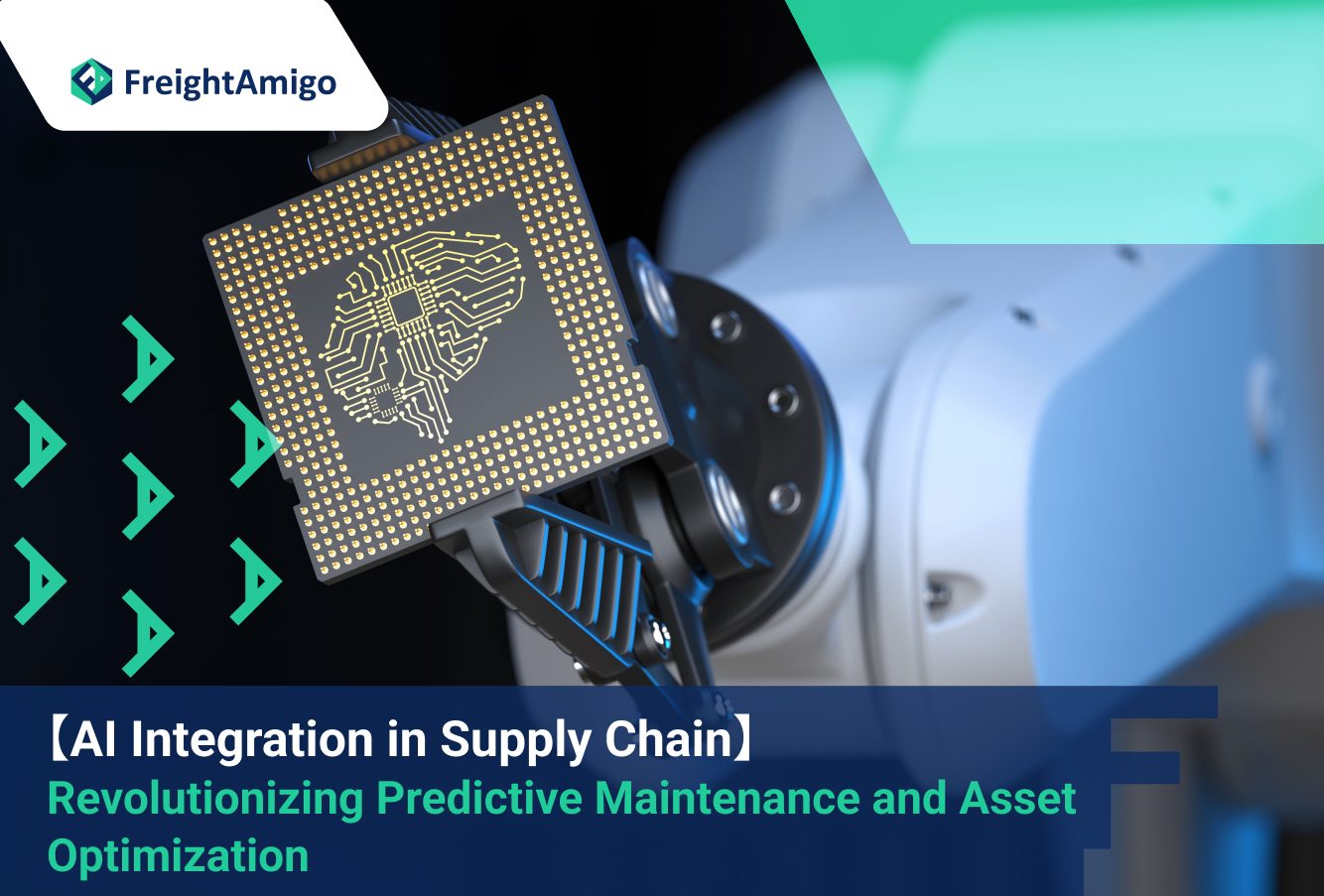January 11th, 2024: Maya Wong – Marketing Analyst at FreightAmigo
In the fast-paced world of modern business, traditional methods of predictive maintenance often fall behind. However, the integration of artificial intelligence (AI) into supply chain operations is revolutionizing the way companies manage their assets and optimize maintenance strategies. AI’s capabilities in anomaly detection, fault prediction, and data analysis have transformed the way businesses predict and prevent equipment failures. By harnessing the power of machine learning, neural networks, and real-time data mining, companies can turn what used to be unavoidable expenses into a finely-tuned strategy for improved efficiency and profitability.
Want To Compare The Best Express, Air Freight, Sea Freight, Rail Freight & Trucking Rates So As To Have Better Control On Cost?
AI’s Impact on Predictive Maintenance and Asset Optimization
The adoption of AI and machine learning technologies in predictive maintenance applications has led to significant growth in the global predictive maintenance market. With a projected market size of $31,965.49 million by 2027, AI is driving the industry forward by reducing machine downtime by 30-50% and improving machine life by 20-40% (McKinsey). Additionally, predictive maintenance programs have been shown to increase equipment availability and uptime by as much as 20%, reduce maintenance costs by 5-10%, and decrease maintenance planning by up to 50% (Deloitte). The potential cost savings are substantial, with predictive asset maintenance saving up to 12% in scheduled repair costs, reducing overall maintenance costs by up to 30%, and resulting in up to 70% fewer breakdowns (Accenture).
AI-powered predictive maintenance solutions are not limited to a specific industry but are being utilized across various sectors such as manufacturing, energy, transportation, and healthcare. As AI technology continues to evolve, we can expect to see more innovative applications in predictive maintenance in the future.
Benefits of AI Integration in Supply Chain
The integration of AI in predictive maintenance offers several benefits for businesses, providing them with a competitive edge in the market. These benefits include:
1. Reduced Downtime
By utilizing AI, businesses can schedule maintenance activities at their convenience, minimizing disruptions to operations. Instead of waiting for a breakdown to occur, AI’s predictive capabilities enable companies to proactively address maintenance needs, reducing downtime and optimizing asset availability.
2.Cost Savings
AI integration in predictive maintenance helps businesses avoid unexpected breakdowns and the high costs associated with emergency repairs. By accurately predicting equipment failures and scheduling maintenance activities accordingly, companies can optimize costs and save on unplanned expenditures.
3.Increased Equipment Lifespan
Through the use of machine learning algorithms and data analysis, AI ensures optimal machine conditions, prolonging the lifespan of equipment. By addressing maintenance needs proactively, businesses can extend the life of their assets and maximize their return on investment.
4.Enhanced Safety
AI’s advanced anomaly detection methods, both supervised and unsupervised, enable early problem identification, contributing to a safer workplace. By detecting and addressing potential issues before they escalate into major failures, AI integration improves overall safety in industrial operations.
5.Asset Optimization
Real-time insights and predictive measures provided by AI allow businesses to utilize their assets more efficiently, maximizing return on investment. By optimizing asset utilization, companies can improve productivity and profitability.
The integration of AI with predictive maintenance and asset optimization is not just an enhancement; it is a revolution in the way businesses manage their operations. By leveraging AI technologies, companies can stay ahead of the curve, predicting faults, optimizing assets, and unlocking a new level of control and efficiency in their supply chain operations.
Roles of AI in Predictive Maintenance and Asset Optimization
AI plays various roles in predictive maintenance and asset optimization, enabling businesses to improve their maintenance strategies and achieve optimal performance. Some of the key roles of AI in this context include:
1.Predicting Equipment Failures and Fault Diagnosis
Predicting equipment failures is no longer a luxury but a necessity in today’s competitive industry. AI in predictive maintenance utilizes machine learning algorithms, anomaly detection techniques, and historical data analysis to forecast potential asset failures. By constantly monitoring data patterns such as temperature, pressure, and vibration, AI can detect even the smallest anomalies, allowing businesses to take corrective action before a small issue escalates into a catastrophic failure.
2.Optimizing Maintenance Schedules
Optimizing maintenance schedules is crucial for effective asset management. AI integration in predictive maintenance allows businesses to tailor maintenance schedules based on asset importance, past failures, and external factors like weather. By analyzing data from various sources, including IoT sensors and historical performance, AI can optimize maintenance schedules, ensuring that maintenance activities are performed only when needed and minimizing downtime.
3.Prioritizing and Recommending Maintenance Tasks
Not all maintenance tasks are equal in terms of urgency and impact on operations. AI can help businesses prioritize maintenance tasks based on their severity and operational impact. By analyzing historical data, current data patterns, and outlier detection, AI can provide actionable recommendations on what maintenance tasks should be done, when they should be done, and who should perform them.
4.Automating Routine Maintenance Tasks
Automation is the key to operational efficiency, especially in maintenance operations. AI enables businesses to automate routine maintenance tasks by processing vast amounts of data from sensors, historical records, and IoT devices. By automating data collection, analysis, and reporting, AI streamlines maintenance operations and frees up valuable human resources for more strategic tasks.
5.Identifying and Analyzing Potential Problems
Early identification of potential problems is essential for preventing costly failures and downtime. AI’s real-time anomaly detection capabilities enable businesses to detect and analyze potential problems before they escalate. By continuously monitoring equipment and analyzing data patterns, AI can uncover hidden trends and correlations that might indicate an emerging problem. This allows businesses to take proactive measures and prevent failures from occurring.
6.Improving Communication Among Stakeholders
Effective communication among stakeholders is crucial for successful maintenance operations. AI can help improve communication by providing intuitive dashboards and reports tailored to the needs of different stakeholders. Real-time alerts and notifications can also be sent to relevant parties when an issue needs attention. By facilitating seamless communication and collaboration, AI enhances overall maintenance effectiveness.
7.Data-Driven Decision-Making
Data-driven decision-making is essential for optimizing maintenance strategies. AI enables businesses to analyze vast amounts of data from various sources, including sensors, historical records, and production data. By uncovering hidden insights and correlations, AI provides valuable information for making informed decisions about maintenance activities, resource allocation, and asset management.
8.Reducing Costs Through Optimization
One of the key benefits of AI integration in predictive maintenance is cost reduction. By optimizing maintenance schedules, automating routine tasks, and utilizing data mining techniques, AI helps businesses reduce maintenance costs and maximize asset value. AI’s predictive capabilities enable businesses to avoid unnecessary maintenance tasks and extend the lifespan of their assets, resulting in significant cost savings.
9.Improving Asset Uptime and Reliability
AI’s predictive capabilities contribute to improved asset uptime and reliability. By detecting and addressing potential issues before they escalate, businesses can minimize downtime and ensure the continuous operation of their assets. AI integration enables businesses to move from reactive maintenance to proactive and predictive operations, resulting in improved asset performance and uptime.
10.Enhancing Safety Measures
Safety is a top priority in industrial operations, and AI can play a vital role in enhancing safety measures. By predicting and preventing equipment failures, AI helps businesses create a safer working environment. Early fault prediction and proactive maintenance reduce the risk of accidents and ensure the safety of employees and assets.
11.Improving Quality Control
AI’s predictive maintenance capabilities can also improve quality control. Assets that are heading towards failure may not operate according to desired specifications, leading to a decline in product quality. By proactively addressing maintenance needs, businesses can ensure that their assets operate at optimal levels, enhancing overall product quality and customer satisfaction.
12.Managing Environmental Impact
Efficient maintenance practices can have a positive environmental impact by reducing waste and optimizing resource utilization. By using AI to optimize maintenance processes, businesses can minimize material waste, reduce energy consumption, and decrease the environmental footprint of their operations. This contributes to sustainable and responsible business practices.
In conclusion, the integration of AI in predictive maintenance and asset optimization is transforming the way businesses manage their supply chain operations. By harnessing the power of AI’s capabilities in anomaly detection, fault prediction, and data analysis, businesses can optimize maintenance schedules, reduce downtime, extend asset lifespan, enhance safety measures, and improve overall operational efficiency. The adoption of AI in predictive maintenance is not just a trend; it is an essential strategy for businesses looking to stay ahead of the competition and achieve long-term success in the global marketplace.
There Are Different Options For Cargo Transportation. If You Want To Choose The Most Convenient And Suitable Solution, It Is Best To Have The Full Support Of Logistics Experts! If You Are Planning To Ship Goods Overseas, Please Go To The FreightAmigo Page For Inquiries.
===
Read More:
【Talk of ChatGPT】 How may it Apply in Logistics and Supply Chain Practices
【Logistics Finance】 Role of AI in Predictive Pricing and Revenue Management
===
If you have any inquiries on logistics/supply chain, feel free to contact FreightAmigo now:
Chat with us online OR
Phone : +852 28121686
WhatsApp: +852 27467829









































